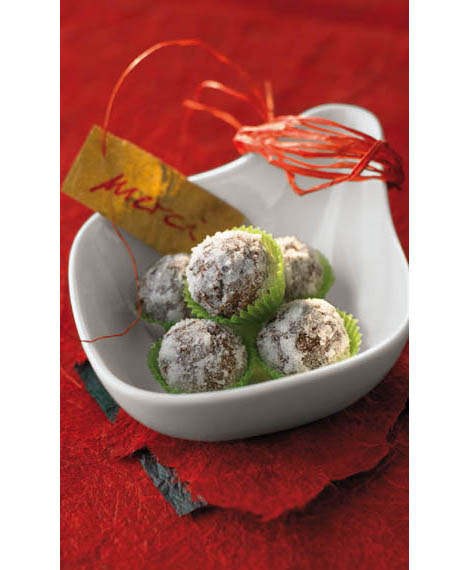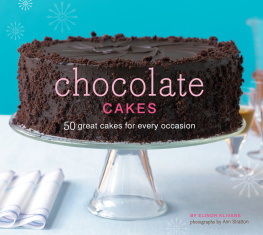Luxury Chocolate
Whether in truffles or sauces, as a light sorbet or a rich cake the melting sweetness of chocolate is irresistible and this book contains a variety of chocolate recipe ideas. Impress your friends and family by creating Chocolate truffles or Chocolate and egg liqueur tart, try out the Chocolate mousse or Chocolate fruits and garnish them with mini chocolate artworks. This recipe collection has something for every chocolate fan!
Naumann & Gbel Verlagsgesellschaft mbH
a subsidiary of VEMAG Verlags- und Medien Aktiengesellschaft
Emil-Hoffmann-Strae 1, 50996 Cologne (Germany)
www.vemag-medien.de
Translation from German: First Edition Translations Ltd
Production: Naumann & Gbel Verlagsgesellschaft mbH
All rights reserved
ISBN 978-3-8155-8790-4
Luxury
Chocolate
Contents
Foreword
Chocolate is a gift from the tropics. Cocoa trees are not particularly hardy and thrive best in the warm, humid regions to the north and south of the Equator, in the African rainforests between the Ivory Coast and Niger and on many Indonesian islands. However, cocoas true origins are found on the banks of the Orinoco and the Amazon in South America and stretch as far as Ecuador and Mexico. It was here that the Aztec god Quetzalcatl personally presented the cocoa tree to the Maya and Aztec peoples. It was here, too, that the Spanish Conquistadores first drank xocolatl, a bitter chocolate drink. And it was here that the Criollo, the original cocoa bean used by the Maya, gained its legendary reputation.


Cocoa and hence chocolate can comprise a whole spectrum of different flavours, ranging from a hint of tropical fruits or liquorice, the aromas of tobacco or smoke to the sweet overtones of honey and caramel. The individual flavour depends, like wine, partly on the type of cocoa bean and partly on the climatic and geological conditions in which it was grown and, last but not least, on the chocolate manufacturer in question. Pure chocolate should consist of no more than four constituents: cocoa paste and cocoa butter, which are extracted from the cocoa beans, sugar and, in some cases, soya lecithin as an emulsifying agent. The addition of milk turns the chocolate into milk chocolate. Chocolate can, of course, be flavoured in many different ways, for example by adding vanilla or other spices.
Cooking and baking with chocolate
The chocolate used in cooking and baking is generally dark chocolate or couverture chocolate with a cocoa content between 7075 %. The difference between the two is determined by the cocoa butter content which is considerably higher in the case of couverture chocolate. The latter is generally easier to use when coating chocolates and cakes. Apart from that, the cocoa content has no bearing on the quality of the chocolate, it merely indicates how bitter or sweet it is. White chocolate contains no cocoa at all but consists simply of cocoa butter mixed with sugar and milk. If you are planning to make your own chocolate treats, always use the best-quality types of chocolate and couverture chocolate. The better the quality of the chocolate, the better the end product.
If you plan to use couverture chocolate to cover your cakes or chocolates, you should bear one important point in mind: the chocolate should first be tempered so that it crystallizes evenly and develops its characteristic shiny gloss. Failure to temper the chocolate will cause it to develop a white bloom, which is a common feature of chocolates which have not been stored properly or have been kept for too long.


There are various methods of tempering chocolate. The simplest method for the home cook is the so-called vaccination method, involving a warm bain-marie, a cooking thermometer and the chocolate couverture. It is carried out as follows: divide the amount of couverture into two portions. Finely grate one portion and break the other into small pieces, melting the latter in a bain-marie. The chocolate should not be allowed to exceed 40 C. Remove the bowl from the water and stir in the grated portion of couverture chocolate, one spoonful at a time until the mixture begins to thicken and the temperature drops below 30 C. The melted chocolate should then be reheated in the bain-marie until it reaches exactly 32 C. It is now ready for use.
Chocolates
and
confectionery
Chocolate truffles

Makes approx. 30 truffles
160 ml cream
250 g dark chocolate (60 % cocoa content)
55 g butter
cocoa powder
approx. 30 paper cases
Melt the cream, chocolate and butter in a saucepan, stirring well. Place in a refrigerator until completely cool. Stir the cream thoroughly and spoon it into an icing bag equipped with a nozzle, then pipe 30 rosettes onto a sheet of baking paper. Keeping your hands as cool as possible, shape the truffle blobs into balls and roll them in cocoa powder. Store the chocolates in a cool place.
Tip: chocolates and truffles, which are made with cream, can only be stored for a limited period. If stored correctly in airtight containers and in a cool place other than the refrigerator they can be kept for approx. 14 days.
White chocolate truffles

Makes approx. 30 truffles
90 ml cream
180 g white chocolate
2 tbsp vanilla liqueur
30 white truffle moulds
100 g white chocolate couverture
Heat the cream in a small saucepan, break the chocolate into small pieces and melt in the cream. Stir in the vanilla liqueur, then remove from the heat. Leave to cool at room temperature, then place in the refrigerator overnight. Using a hand mixer, whisk until the mixture is light and airy, then spoon it into an icing bag and pipe into the truffle moulds. Place in the refrigerator.
Temper the couverture chocolate. Remove the truffle balls from the refrigerator, dip them in the melted chocolate glaze, allow any excess chocolate to drip off and place on a fine mesh cooling rack. Leave to cool. The addition of a pinch of cinnamon, cardamom and cloves to the truffle cream gives the truffles a Christmassy flavour. Alternatively, a small sachet of saffron, steeped in vanilla liqueur, will give the truffles an extra touch of sophistication.
Butter and vanilla truffles

Makes approx. 60 truffles
2 vanilla pods
250 g soft butter
80 g cocoa butter
100 g icing sugar
250 g white chocolate couverture
600 g milk chocolate couverture
500 g castor sugar or icing sugar
approx. 60 paper cases
Cut the vanilla pods in half lengthwise and scoop out the insides. Cream together the vanilla pulp, soft butter, cocoa butter (at room temperature) and icing sugar for at least 10 minutes until frothy. Meanwhile, melt the white chocolate couverture in a bain-marie and set aside to cool. Mix the cooled but still soft chocolate into the butter mixture.
Next page






















